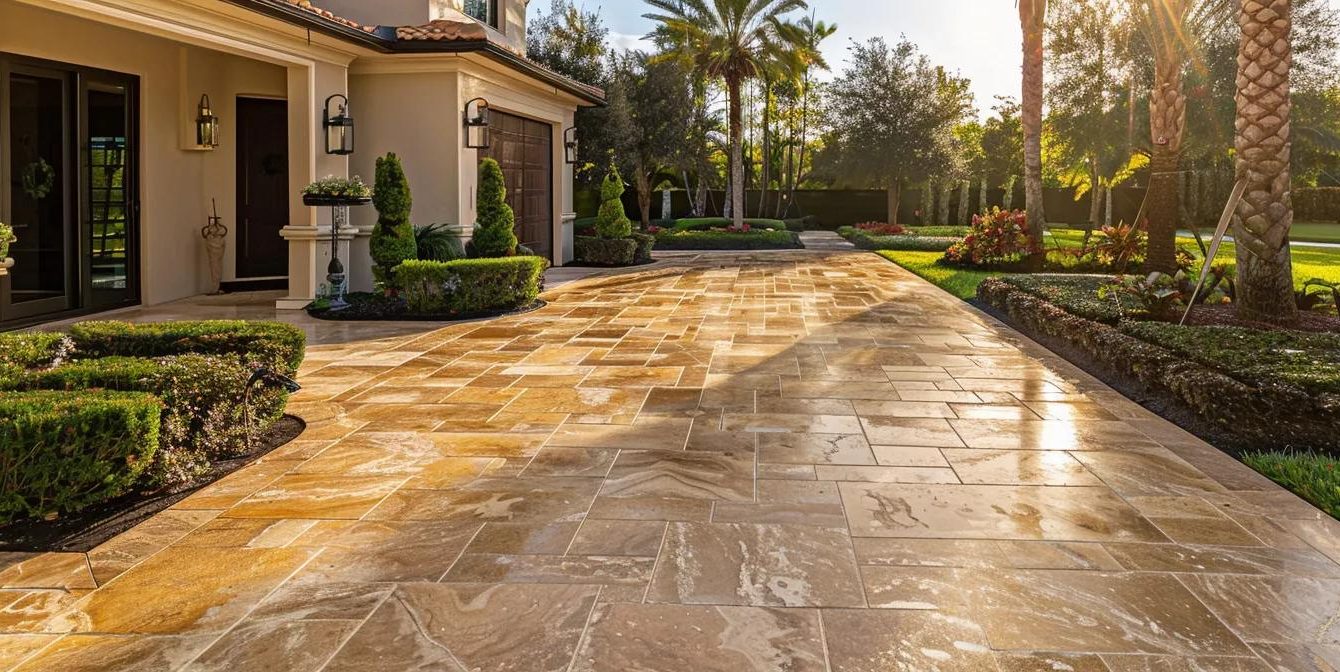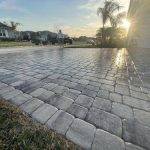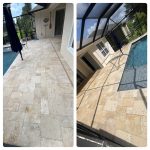Maintaining outdoor travertine surfaces can be challenging. This guide provides essential insights on travertine sealing for outdoor areas. We’ll cover the benefits of sealing, choosing the right products, preparing surfaces, applying sealant correctly, and maintaining sealed travertine. By following these steps, you’ll protect your travertine from weather damage and stains, extending its lifespan and preserving its beauty. Sealer Pro LLC offers expert travertine sealing services to help you achieve the best results for your outdoor spaces.
Key Takeaways
- Sealing travertine outdoors protects against damage, maintains aesthetics, improves longevity, prevents staining, and enhances safety
- Proper preparation, including cleaning and repairing cracks, is crucial for effective travertine sealing outdoors
- Choosing the right sealing products and following manufacturer instructions ensure optimal protection for outdoor travertine surfaces
- Regular cleaning, timely reapplication of sealant, and prompt addressing of issues maintain the longevity of sealed travertine
- Professional inspections help identify potential problems and provide tailored maintenance advice for outdoor travertine surfaces
Understand the Benefits of Sealing Travertine Outdoors
Sealing travertine outdoors offers numerous benefits for property owners. It protects surfaces against damage and weathering, maintains aesthetic appeal, improves longevity, prevents staining, and enhances safety. Proper sealing techniques, which may involve pressure washing, sand and sandpaper, can significantly extend the life of travertine floors and outdoor installations. For a free estimate on professional sealing services, contact sealer pro llc.
Protect Your Outdoor Surfaces Against Damage and Weathering
Sealing travertine outdoors provides essential protection against damage and weathering, safeguarding property owners’ investments. This protective barrier shields surfaces from water damage, preventing moisture from seeping into the porous stone and causing deterioration. In areas like San Antonio, where weather conditions can be harsh, sealed travertine maintains its integrity and appearance for longer periods.
The sealing process also guards against stains from substances like red wine, which can be particularly troublesome on outdoor surfaces. For those with travertine countertops or flooring in outdoor kitchens, proper sealing not only preserves the stone’s natural beauty but also saves money on potential repairs or replacements in the long run. Professional sealing services ensure comprehensive protection for all outdoor travertine surfaces.
Maintain the Aesthetic Appeal of Your Travertine Stone
Sealing travertine outdoors preserves its natural beauty and protects it from environmental factors that can cause discoloration or damage. This process guards against stains from substances like wine and rust, which are common concerns for outdoor spaces such as pool decks. Proper sealing maintains the stone’s aesthetic appeal, ensuring it retains its elegant appearance despite exposure to rain and other elements.
For homeowners with travertine pool surrounds, sealing is particularly crucial. It prevents water absorption and mineral deposits from pool chemicals, keeping the stone looking pristine. Additionally, sealed travertine resists etching and fading from sun exposure, maintaining its color and texture for years to come. This preservation of aesthetics enhances the overall look of outdoor living spaces, contributing to the property’s value and appeal.
Improve the Longevity of Your Outdoor Travertine Installations
Sealing travertine outdoors significantly enhances its longevity by creating a protective bead on the surface, reducing porosity. This barrier prevents water infiltration and mold growth, which can deteriorate the stone over time. Properly sealed travertine maintains its structural integrity and appearance, even in harsh outdoor environments.
Professional sealers often use products with high ratings for durability and UV resistance, ensuring long-lasting protection. Environmentally friendly sealants are available, offering effective protection without harmful chemicals. Regular resealing, typically every 3-5 years depending on exposure, maintains the travertine’s protective layer and extends its lifespan considerably.
Prevent Staining and Discoloration From Oils and Spills
Sealing travertine outdoors creates a protective barrier against stains and discoloration caused by oils and spills. This protection extends to various outdoor surfaces, including driveways and areas around water features, where spills are common. The sealant prevents liquids from penetrating the porous surface of travertine and sandstone, maintaining their natural appearance.
Professional sealing services often offer warranties for their work, ensuring long-lasting protection for travertine pavers and other outdoor stone surfaces. By applying a high-quality sealant, property owners can safeguard their investment and reduce the need for frequent cleaning or restoration. This preventive measure is particularly valuable for outdoor entertaining areas where food and drink spills are likely to occur.
Enhance Safety by Reducing Slipperiness in Wet Conditions
Sealing travertine outdoors enhances safety by reducing slipperiness in wet conditions. The sealant fills the porous surface of travertine, creating a smoother texture that provides better traction when wet. This is particularly important for areas around pools, where water splashes can make surfaces slippery, or in regions with frequent rainfall.
Professional sealing services often offer options for adding grip-enhancing additives to the sealant. These additives, which may include fine particles of glass or concrete, increase traction without altering the travertine’s natural colors. For areas prone to soil accumulation, sealed surfaces are easier to clean, reducing the risk of slippery organic buildup. The sealing process typically involves the following steps:
- Cleaning the travertine surface thoroughly
- Allowing the surface to dry completely
- Applying the sealant with a sponge or roller
- Adding grip-enhancing additives if desired
- Allowing the sealant to cure fully
Identify the Best Sealing Products for Travertine
Selecting the right sealing products for travertine is crucial for outdoor protection. This section examines penetrating and topical sealers, compares water-based and solvent-based options, highlights reputable brands for travertine care, and emphasizes the importance of customer reviews. Understanding these factors helps property owners make informed decisions to safeguard their mineral investment with an effective protective coat.
Choose Between Penetrating and Topical Sealers
Penetrating sealers offer deep protection for travertine and limestone, preserving their natural beauty while providing resistance against stains and weathering. These sealers penetrate the porous surface, creating a protective barrier without altering the stone’s appearance. For outdoor applications, penetrating sealers prove particularly effective in guarding against water damage and maintaining the travertine’s natural slip resistance.
Topical sealers, on the other hand, form a protective layer on the surface of travertine, offering enhanced stain resistance and a glossy finish that can accentuate the stone’s natural patterns. While topical sealers provide excellent protection for indoor granite surfaces, they may require more frequent reapplication in outdoor settings due to exposure to elements. Property owners should consider factors such as foot traffic and exposure to chemicals like pool water when choosing between penetrating and topical sealers for their outdoor travertine surfaces.
Evaluate Water-Based Versus Solvent-Based Sealers
Water-based sealers offer advantages for travertine floors and walkways in outdoor settings. These sealers provide excellent absorption into the stone while allowing it to breathe, reducing the risk of moisture damage. They are ideal for areas with high foot traffic, such as Dallas, where durability and ease of cleaning are essential.
Solvent-based sealers, on the other hand, penetrate deeper into travertine surfaces, offering superior protection against stains and weathering. These sealers are particularly effective for outdoor applications where exposure to elements is a concern. However, they may require more careful application and longer drying times compared to water-based alternatives:
| Sealer Type | Advantages | Disadvantages |
|---|---|---|
| Water-Based | Eco-friendly, easy application, quick drying | May require more frequent reapplication |
| Solvent-Based | Deep penetration, long-lasting protection | Stronger odor, longer drying time |
Research Popular Brands Known for Travertine Care
Popular brands for travertine care offer specialized sealants designed to protect outdoor surfaces from wear and environmental damage. These products often come with specific applicators, such as sprayers, to ensure even coverage and efficient application. Quality sealants penetrate the porous surface of travertine, providing long-lasting protection against moisture and stains.
When selecting a brand, property owners should consider factors such as durability, UV resistance, and ease of maintenance. Some manufacturers provide detailed instructions for application, including recommendations for using protective gear like cotton gloves during the sealing process. It’s important to choose a brand that offers products compatible with outdoor use and can withstand exposure to various weather conditions.
Read Reviews and Customer Feedback on Products
Customer reviews provide valuable insights into the performance of travertine sealers in various outdoor settings, from bathrooms to kitchens. Property owners can learn about a product’s effectiveness against mildew and stains, helping them make informed decisions for their specific needs. Reviews often highlight the longevity of sealers and their ability to maintain the natural beauty of travertine surfaces.
Feedback from experts in the field can offer technical details about sealer application and maintenance. These reviews may address concerns such as slip resistance in wet areas or the sealer’s impact on travertine’s porous nature. By analyzing customer experiences, property owners can gauge a product’s suitability for their outdoor travertine installations, ensuring optimal protection and aesthetics.
Prepare Your Travertine for Effective Sealing
Proper preparation is crucial for effective travertine sealing outdoors. This section covers essential steps: thorough cleaning, repairing cracks, moisture testing, and ensuring proper drying. These processes, which may involve removing dust and restoring the ivory tone of tiles, are vital for optimal sealer adhesion and long-lasting protection of travertine surfaces.
Clean the Surface Thoroughly Before Application
Thorough cleaning of travertine surfaces is crucial before applying sealer. Property owners should remove all dirt, debris, and existing paint using appropriate cleaning solutions, avoiding harsh chemicals like bleach that can damage the stone. A clean surface ensures proper adhesion of the sealer, enhancing its effectiveness and longevity.
After cleaning, it’s essential to allow the travertine to dry completely before sealing. Moisture trapped beneath the sealer can lead to clouding and reduce its effectiveness, especially on outdoor patios. Professional sealing services often use moisture meters to ensure the surface is adequately dry before application, guaranteeing optimal results for travertine protection.
Repair Any Cracks or Chips in the Stone
Repairing cracks and chips in travertine is crucial before applying sealant to outdoor surfaces. Homeowners should inspect their travertine decks, walls, and pavers for any damage, as even small imperfections can compromise the effectiveness of sealing services. Professional paver sealing services often include crack repair as part of their comprehensive home improvement packages.
For minor repairs, property owners can use epoxy fillers designed specifically for natural stone. These fillers bond well with travertine and can be color-matched to maintain a seamless appearance. Larger cracks or chips may require the expertise of a professional to ensure proper repair and preservation of the travertine’s structural integrity before sealing.
Test for Moisture With the Water Test Method
The water test method is a crucial step in preparing travertine for outdoor sealing. Property owners should apply a small amount of water to various areas of the travertine surface, including areas near gardens or showers. If the water beads up and remains on the surface, it indicates that previous sealant is still effective.
However, if the water absorbs quickly into the travertine, it signals that the stone requires sealing. This test helps identify areas prone to oil or salt penetration, which is particularly important for outdoor travertine exposed to various elements. Property owners should conduct this test in multiple locations to ensure comprehensive protection:
- Near water features or garden areas
- On high-traffic pathways
- Around outdoor cooking spaces
- In areas exposed to pool chemicals or salt spray
Ensure the Area Is Properly Dried Before Sealing
Proper drying of travertine surfaces is crucial before applying sealant. Property owners should ensure their outdoor travertine areas, including those with diamond or onyx inlays, are completely dry to prevent moisture from becoming trapped beneath the sealant. In Los Angeles, where humidity levels can vary, professionals often use specialized equipment to verify surface dryness.
After cleaning, travertine surfaces should be allowed to air dry for at least 24 to 48 hours, depending on environmental conditions. This drying period is essential for maintaining the aesthetics of the stone and ensuring optimal sealant adhesion. Property owners should avoid applying wax or other products during this time, as they can interfere with the sealing process:
| Drying Method | Duration | Recommended For |
|---|---|---|
| Natural Air Drying | 24-48 hours | Most outdoor travertine surfaces |
| Fan-Assisted Drying | 12-24 hours | Areas with high humidity |
| Dehumidifier Use | 6-12 hours | Enclosed outdoor spaces |
Apply Travertine Sealant Correctly for Optimal Results
Proper application of travertine sealant is crucial for optimal protection of outdoor surfaces, including travertine pool decks in Arizona. This section covers essential steps: using appropriate tools, following manufacturer instructions, allowing proper curing time, and considering weather conditions. These guidelines ensure effective sealing, preserving the beauty of travertine and marble surfaces while enhancing their durability against outdoor elements.
Use the Appropriate Tools for Even Application
Proper tool selection ensures even application of sealant on travertine surfaces, minimizing wear and tear over time. A high-quality brush or roller designed for natural stone sealants provides consistent coverage, reaching into the porous structure of travertine and adjacent spaces. This method effectively protects against dirt infiltration, especially in outdoor areas where exposure to elements is constant.
For larger outdoor travertine installations, professionals often use sprayers to apply sealant efficiently. These tools allow for rapid coverage of expansive areas, such as travertine pool decks or patios, ensuring uniform protection. When sealing mixed surfaces that include both travertine and porcelain, applicators should choose tools that accommodate the different absorption rates of these materials, maintaining consistent results across diverse outdoor spaces.
Follow Manufacturer Instructions for Application Timing
Proper application timing is crucial for optimal travertine sealing results. Manufacturers provide specific instructions for application intervals, which vary depending on factors such as temperature and humidity. In Leesburg, where weather conditions can fluctuate, property owners should closely follow these guidelines to ensure the stone sealer’s effectiveness against heat and chlorine exposure.
Many stone sealers require multiple coats for maximum protection, with specified waiting periods between applications. Adhering to these intervals allows each layer to penetrate and bond properly, creating a robust barrier against outdoor elements. For travertine surfaces near pool areas, where exposure to chlorine is common, following the manufacturer’s timing recommendations is particularly important to achieve optimal resistance:
| Application Step | Recommended Timing | Environmental Considerations |
|---|---|---|
| First Coat | Apply when surface is completely dry | Avoid application in direct sunlight or extreme heat |
| Subsequent Coats | Wait 2-4 hours between coats | Adjust timing based on humidity levels |
| Final Curing | Allow 24-48 hours before use | Protect from moisture during curing period |
Allow Sealant to Cure for Recommended Duration
Allowing travertine sealant to cure for the recommended duration is crucial for optimal protection, especially in outdoor settings like Houston where pressure from foot traffic and debris can impact surfaces. Property owners should adhere to manufacturer guidelines, typically ranging from 24 to 72 hours, to ensure the sealant fully bonds with the travertine and grout, creating a durable barrier against moisture and stains.
During the curing process, it’s essential to protect the sealed travertine from water exposure and heavy use. This precaution is particularly important for outdoor mosaic patterns or areas near water features, where premature exposure to moisture can compromise the sealant’s effectiveness. Professionals recommend covering the sealed area with protective sheets and redirecting foot traffic until the curing process is complete.
Avoid Application During Extreme Weather Conditions
Applying travertine sealant during extreme weather conditions can compromise its effectiveness and durability. Property owners should avoid sealing outdoor travertine surfaces during periods of high humidity, intense heat, or cold temperatures. These conditions can affect the sealant’s ability to bond properly with the stone, potentially leading to inadequate protection against moisture and stains.
Ideal weather conditions for travertine sealing include moderate temperatures between 50°F and 80°F with low humidity. Professional sealing services often schedule outdoor projects during optimal weather windows to ensure the best results. When planning a sealing project, property owners should consider the following factors:
- Temperature range suitable for sealant application
- Humidity levels and their impact on drying time
- Forecast for rain or other precipitation
- Sun exposure and its effect on surface temperature
- Wind conditions that may affect even application
Maintain Sealed Travertine Surfaces for Longevity
Maintaining sealed travertine surfaces is crucial for their longevity outdoors. Property owners should regularly clean sealed areas, reapply sealant as recommended, address issues promptly, and schedule professional inspections. These practices ensure the continued protection and beauty of outdoor travertine installations, preserving their value and appearance over time.
Regularly Clean Your Sealed Travertine Surfaces
Regular cleaning of sealed travertine surfaces maintains their appearance and prolongs the effectiveness of the sealant. Property owners should use pH-neutral cleaners specifically designed for natural stone to avoid damaging the protective layer. Sweeping or vacuuming outdoor travertine areas regularly removes abrasive particles that can wear down the sealant over time.
For outdoor travertine installations, periodic deep cleaning with a pressure washer set at low pressure helps remove stubborn dirt and grime. Sealer Pro LLC recommends avoiding acidic cleaners or harsh chemicals, as these can etch the stone and compromise the sealant’s integrity. Prompt cleaning of spills and stains prevents them from penetrating the sealed surface, ensuring the longevity of outdoor travertine features.
Reapply Sealant Based on Manufacturer Recommendations
Property owners should adhere to manufacturer recommendations for reapplying sealant to outdoor travertine surfaces. These guidelines typically suggest reapplication every 3-5 years, depending on factors such as exposure to sunlight, foot traffic, and weather conditions. Regular assessment of the travertine’s water absorption can help determine when resealing is necessary, ensuring consistent protection against stains and weathering.
Professional sealing services often offer maintenance plans that include scheduled reapplications based on the specific needs of each property. These plans consider the unique environmental factors affecting outdoor travertine installations, such as proximity to pool areas or exposure to salt air in coastal regions. By following a structured resealing schedule, property owners can maintain the aesthetic appeal and durability of their travertine surfaces, extending their lifespan and preserving their value.
Address Any Issues Promptly to Prevent Damage
Prompt attention to issues with sealed travertine surfaces is crucial for preventing long-term damage. Property owners should regularly inspect their outdoor travertine installations for signs of wear, such as discoloration, etching, or water absorption. Addressing these issues quickly can prevent more extensive damage and maintain the integrity of the sealing protection.
Professional sealing services recommend immediate action for specific problems, such as stains from organic matter or chemical spills. Sealer Pro LLC advises clients to have a maintenance plan in place for quick responses to potential damage. This proactive approach helps preserve the aesthetic appeal and structural integrity of outdoor travertine surfaces, ensuring their longevity and value:
| Issue | Recommended Action | Timeframe |
|---|---|---|
| Organic Stains | Clean with pH-neutral cleaner | Within 24 hours |
| Chemical Spills | Neutralize and rinse thoroughly | Immediately |
| Visible Wear | Assess for resealing needs | Within 1 week |
Schedule Professional Inspections for Your Outdoor Stone
Professional inspections of outdoor travertine surfaces are crucial for maintaining their longevity and appearance. Experts recommend scheduling annual assessments to identify potential issues before they escalate into costly repairs. These inspections evaluate the integrity of the sealant, check for signs of wear or damage, and assess the overall condition of the travertine.
During these evaluations, professionals can provide tailored advice on maintenance practices specific to the property’s environment. They may suggest adjustments to cleaning routines, recommend resealing schedules, or propose treatments to address emerging concerns. Regular professional inspections ensure that outdoor travertine surfaces remain protected and beautiful for years to come.
Conclusion
Sealing travertine for outdoor use is essential for protecting against damage, maintaining aesthetic appeal, and enhancing safety. Proper preparation, application, and maintenance are crucial for optimal results, including thorough cleaning, crack repair, and following manufacturer instructions. Regular care, including prompt issue resolution and professional inspections, ensures the longevity and durability of sealed travertine surfaces. By understanding and implementing these essential insights, property owners can preserve their investment, enhance their outdoor spaces, and enjoy the beauty of travertine for years to come.









